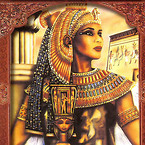
Tutankhamun - In 1925 archaeologist Howard Carter found two dagger's in
the mummy of the young pharaoh Tutankhamun ,
mummification , more than 3,300 years ago,
one of them an iron and the other a gold blade.
Scientists have for decades been plagued by the Tutankhamun golden dagger blade with the golden handle, the crystal rocky side and the blade decorated with lily flower and jackal. Ironwork was rare in ancient Egypt, and iron in the dagger was not rusted, according to a report by The British Guardian .
Tutankhamun 's Dagger Does it originate from space?

Egyptian and Italian researchers examined the metal using an X-ray spectrometer to determine its chemical composition. They found its structure rich in nickel and cobalt, "strongly indicating its origin." Scientists compared the structure to meteorites that fell within 2,000 km of the Egyptian Red Sea coasts. The levels in one of these meteorites are very close.

Tutankhamun
The meteorite, whose proportions coincided with the dagger, was called the "Kharja" meteorite.
It was found in the city of Marsa Matruh, 240 km west of Alexandria. Marsa Matruh was under the reign of Alexander the Great in the 4th century BC known as Ammonia.
The research was published Tuesday 31 May 2016 in Meteoritics & Planetary Science.
Although the ancients knew about them copper
and bronze works since the fourth millennium BC , but the ironwork .
did not appear until later and was known rare in Egypt.
In 2013 it was found that 9 colored iron beads were extracted from a tomb in northern Egypt near the Nile,
which was struck by meteorite fragments and a combination of iron and nickel. The beads date back to the pre-Pharaoh era in 3200 BC
Iron of the sky
Scientists have noted that ancient Egyptians in the 13th century BC used a word literally translated "iron of the sky" to describe all kinds of iron, a metal that gave special prominence to the manufacture of ornamental and religious rites.

The researchers wrote: "The introduction of this term in the name of the boat into their language
means that the ancient Egyptians were aware
since the 13th century BC that these pieces of iron came down from the sky,
which means.
they have preceded the Western culture more than 2000 years..
In an interview with Nature magazine, she said that in her research on iron beads, everything falling from the sky was a gift from the gods. .
The high quality of the stiletto blade indicates that Tutankhamun,
who lived in the late Bronze Age, was surrounded by a skilled blacksmith, .
despite the relative scarcity of iron at that time .
Perhaps the code is not the only one in the pharaoh's tomb made of falling meteorites.

In 2006, an Austrian scientist in space chemistry came up with a hypothesis that a strange,
ungainly stone shaped like a black eagle in a pharaoh's burial necklace is actually a glass
formed by the intense heat of a falling meteor impact.
The secret of these techniques
"It would be interesting for us to examine more pre-Iron Age pieces,
such as other iron pieces that may be found in the tomb of .
King Tutankhamun,
" said Daniela Comili, of the physics department at Milan Polytechnic University.
Because we may be able .
To recognize the secrets of ironwork techniques in ancient Egypt and the Mediterranean. "

Tutankhamun
You may also like this
Dogs in Ancient Egypt
Click to Post

